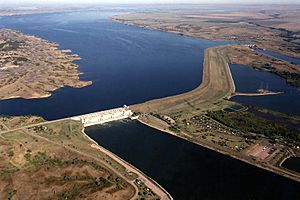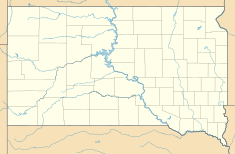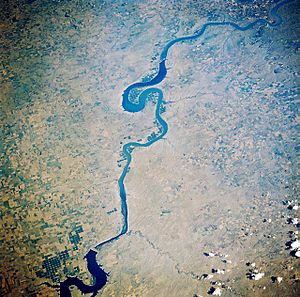Big Bend Dam facts for kids
Quick facts for kids Big Bend Dam |
|
|---|---|

Big Bend Dam on the Missouri River, with Lake Sharpe in the background.
|
|
|
Location of Big Bend Dam in the State of South Dakota.
|
|
| Official name | Big Dam |
| Country | United States |
| Location | Buffalo/Lyman Counties, South Dakota. |
| Coordinates | 44°02′58″N 99°26′55″W / 44.049473°N 99.448586°W |
| Status | Operational |
| Construction began | 1959 |
| Opening date | 1963 |
| Construction cost | $107 million |
| Owner(s) | |
| Dam and spillways | |
| Type of dam | Embankment, Rolled-earth shale fill & chalk fill |
| Impounds | Missouri River |
| Height | 95 ft (29 m) |
| Length | 10,570 ft (3,222 m) (including spillway) |
| Elevation at crest | 1,423 feet msl |
| Width (base) | 1,200 ft (366 m) |
| Dam volume | 17,000,000 cu yd (12,997,433 m3) |
| Spillways | 8 - 40-foot x 38-foot tainter gates |
| Spillway type | controlled (gated) |
| Spillway capacity | 270,000 cfs at 1,423 feet msl |
| Reservoir | |
| Creates | Lake Sharpe |
| Total capacity | 1,798,000 acre⋅ft (2.217800344×109 m3) |
| Catchment area | 5,840 sq mi (15,126 km2) |
| Surface area | 56,884 acres (23,020 ha) |
| Maximum length | 80 mi (129 km) |
| Maximum water depth | 78 ft (24 m) |
| Normal elevation | 1,420-1,423 feet msl |
| Power station | |
| Operator(s) | U.S. Army Corps of Engineers |
| Commission date | October 1964 |
| Turbines | 8 Fixed blade, 81.8 rpm |
| Installed capacity | 494,320 kW |
| Annual generation | 969 million kilowatt hours |
| Website U.S. Army Corps of Engineers - Big Bend Dam / Lake Sharpe |
|
The Big Bend Dam is a huge dam on the Missouri River in central South Dakota, United States. It was built by the U.S. Army Corps of Engineers. This dam helps control floods and creates electricity for many homes. It also forms a large lake called Lake Sharpe.
Construction of the dam started in 1959. The main part of the dam was finished in 1963. The dam began making electricity in 1964. The whole project was completed in 1966. It cost about $107 million to build. The power plant can make 493,300 kilowatts of electricity. This is enough to power many homes and businesses.
Contents
About Lake Sharpe
Big Bend Dam is located near Fort Thompson, South Dakota. It sits close to a big curve in the Missouri River called the Big Bend. The dam creates Lake Sharpe, which is named after South Dakota Governor Merrill Q. Sharpe.
Lake Sharpe stretches for about 80 miles (129 km) upstream. It goes past Pierre, the state capital. The lake ends at Oahe Dam, another important dam. Lake Sharpe covers a huge area of about 56,884 acres (230 km²). It collects water from a very large area, almost 250,000 square miles (647,500 km²).
Getting to the Dam
South Dakota Highway 47 goes right over the dam. This road connects Lyman and Buffalo Counties. Big Bend Dam is about 17 miles (27 km) north of I-90. It is also about 60 miles (97 km) southeast of Pierre.
The next dam upstream from Big Bend Dam is Oahe Dam. This dam is near Pierre. The next dam downstream is Fort Randall Dam. It is located near Pickstown.
Impact on Native American Tribes
Building the Big Bend Dam had a big impact on local Native American tribes. People from the Crow Creek and Lower Brule Reservations had to move from their homes. The new lake also covered land that had important plants. These plants were used by the tribes for food and medicine.
In 2002, a special monument was built at Big Bend Dam. It is called the Spirit of the Circle Monument. This monument honors more than 1,300 people. They died during the 1860s at the Crow Creek Reservation. This reservation is near where the dam is today.
The 2011 Missouri River Flood
In 2011, there was a very big flood on the Missouri River. For the first time ever, the dam's spillway gates had to be fully opened. This happened on June 3, 2011. The dam released a massive amount of water. It was releasing 150,000 cubic feet (4,248 m³) of water every second. This was much more than its previous record release. The previous record was 74,000 cubic feet (2,096 m³) per second in 1997. Opening the gates helped manage the floodwaters.



